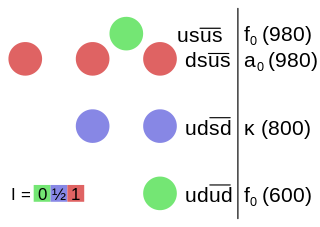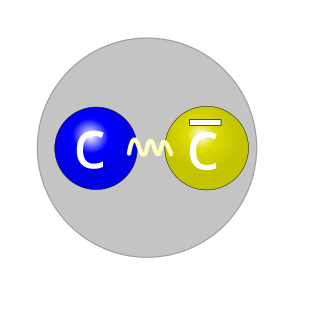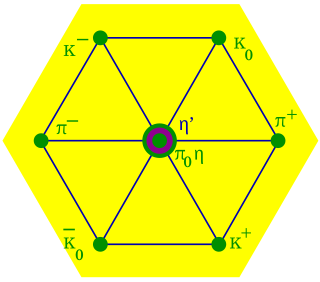Related Research Articles

In particle physics, a hadron is a composite subatomic particle made of two or more quarks held together by the strong interaction. They are analogous to molecules that are held together by the electric force. Most of the mass of ordinary matter comes from two hadrons: the proton and the neutron, while most of the mass of the protons and neutrons is in turn due to the binding energy of their constituent quarks, due to the strong force.

In theoretical physics, quantum chromodynamics (QCD) is the theory of the strong interaction between quarks mediated by gluons. Quarks are fundamental particles that make up composite hadrons such as the proton, neutron and pion. QCD is a type of quantum field theory called a non-abelian gauge theory, with symmetry group SU(3). The QCD analog of electric charge is a property called color. Gluons are the force carriers of the theory, just as photons are for the electromagnetic force in quantum electrodynamics. The theory is an important part of the Standard Model of particle physics. A large body of experimental evidence for QCD has been gathered over the years.

A pentaquark is a human-made subatomic particle, consisting of four quarks and one antiquark bound together; they are not known to occur naturally, or exist outside of experiments specifically carried out to create them.

Technicolor theories are models of physics beyond the Standard Model that address electroweak gauge symmetry breaking, the mechanism through which W and Z bosons acquire masses. Early technicolor theories were modelled on quantum chromodynamics (QCD), the "color" theory of the strong nuclear force, which inspired their name.

In particle physics, a tetraquark is an exotic meson composed of four valence quarks. A tetraquark state has long been suspected to be allowed by quantum chromodynamics, the modern theory of strong interactions. A tetraquark state is an example of an exotic hadron which lies outside the conventional quark model classification. A number of different types of tetraquark have been observed.

In particle physics, exotic mesons are mesons that have quantum numbers not possible in the quark model; some proposals for non-standard quark model mesons could be:

In particle physics, a glueball is a hypothetical composite particle. It consists solely of gluon particles, without valence quarks. Such a state is possible because gluons carry color charge and experience the strong interaction between themselves. Glueballs are extremely difficult to identify in particle accelerators, because they mix with ordinary meson states. In pure gauge theory, glueballs are the only states of the spectrum and some of them are stable.

The
J/ψ
(J/psi) meson is a subatomic particle, a flavor-neutral meson consisting of a charm quark and a charm antiquark. Mesons formed by a bound state of a charm quark and a charm anti-quark are generally known as "charmonium" or psions. The
J/ψ
is the most common form of charmonium, due to its spin of 1 and its low rest mass. The
J/ψ
has a rest mass of 3.0969 GeV/c2, just above that of the
η
c, and a mean lifetime of 7.2×10−21 s. This lifetime was about a thousand times longer than expected.

In high-energy physics, a pseudoscalar meson is a meson with total spin 0 and odd parity . Pseudoscalar mesons are commonly seen in proton-proton scattering and proton-antiproton annihilation, and include the pion, kaon, eta, and eta prime particles, whose masses are known with great precision.
The QCD vacuum is the quantum vacuum state of quantum chromodynamics (QCD). It is an example of a non-perturbative vacuum state, characterized by non-vanishing condensates such as the gluon condensate and the quark condensate in the complete theory which includes quarks. The presence of these condensates characterizes the confined phase of quark matter.

Exotic hadrons are subatomic particles composed of quarks and gluons, but which – unlike "well-known" hadrons such as protons, neutrons and mesons – consist of more than three valence quarks. By contrast, "ordinary" hadrons contain just two or three quarks. Hadrons with explicit valence gluon content would also be considered exotic. In theory, there is no limit on the number of quarks in a hadron, as long as the hadron's color charge is white, or color-neutral.

In particle physics, the quark model is a classification scheme for hadrons in terms of their valence quarks—the quarks and antiquarks that give rise to the quantum numbers of the hadrons. The quark model underlies "flavor SU(3)", or the Eightfold Way, the successful classification scheme organizing the large number of lighter hadrons that were being discovered starting in the 1950s and continuing through the 1960s. It received experimental verification beginning in the late 1960s and is a valid effective classification of them to date. The model was independently proposed by physicists Murray Gell-Mann, who dubbed them "quarks" in a concise paper, and George Zweig, who suggested "aces" in a longer manuscript. André Petermann also touched upon the central ideas from 1963 to 1965, without as much quantitative substantiation. Today, the model has essentially been absorbed as a component of the established quantum field theory of strong and electroweak particle interactions, dubbed the Standard Model.

The Upsilon meson is a quarkonium state formed from a bottom quark and its antiparticle. It was discovered by the E288 experiment team, headed by Leon Lederman, at Fermilab in 1977, and was the first particle containing a bottom quark to be discovered because it is the lightest that can be produced without additional massive particles. It has a lifetime of 1.21×10−20 s and a mass about 9.46 GeV/c2 in the ground state.
In particle physics, chiral symmetry breaking generally refers to the dynamical spontaneous breaking of a chiral symmetry associated with massless fermions. This is usually associated with a gauge theory such as quantum chromodynamics, the quantum field theory of the strong interaction, and it also occurs through the Brout-Englert-Higgs mechanism in the electroweak interactions of the standard model. This phenomenon is analogous to magnetization and superconductivity in condensed matter physics. The basic idea was introduced to particle physics by Yoichiro Nambu, in particular, in the Nambu–Jona-Lasinio model, which is a solvable theory of composite bosons that exhibits dynamical spontaneous chiral symmetry when a 4-fermion coupling constant becomes sufficiently large. Nambu was awarded the 2008 Nobel prize in physics "for the discovery of the mechanism of spontaneous broken symmetry in subatomic physics."

William Allan Bardeen is an American theoretical physicist who worked at the Fermi National Accelerator Laboratory. He is renowned for his foundational work on the chiral anomaly, the Yang-Mills and gravitational anomalies, the development of quantum chromodynamics and the scheme frequently used in perturbative analysis of experimentally observable processes such as deep inelastic scattering, high energy collisions and flavor changing processes.

Christopher T. Hill is an American theoretical physicist at the Fermi National Accelerator Laboratory who did undergraduate work in physics at M.I.T., and graduate work at Caltech. Hill's Ph.D. thesis, "Higgs Scalars and the Nonleptonic Weak Interactions" (1977) contains one of the first detailed discussions of the two-Higgs-doublet model and its impact upon weak interactions.
The eta and eta prime meson are isosinglet mesons made of a mixture of up, down and strange quarks and their antiquarks. The charmed eta meson and bottom eta meson are similar forms of quarkonium; they have the same spin and parity as the (light)
η
defined, but are made of charm quarks and bottom quarks respectively. The top quark is too heavy to form a similar meson, due to its very fast decay.

Stephan Narison is a Malagasy theoretical high-energy physicist specialized in quantum chromodynamics (QCD), the gauge theory of strong interactions. He is the founder of the Series of International Conferences in Quantum Chromodynamics (QCD-Montpellier) and of the Series of International Conferences in High-Energy Physics (HEPMAD-Madagascar).
References
- ↑ Ishida, M.Y. (1998). "Existence of σ(600)-particle and new chiral scalar nonet". Nuclear Physics A. Elsevier BV. 629 (1–2): 148–151. arXiv: hep-ph/9712231 . Bibcode:1998NuPhA.629..148I. doi:10.1016/s0375-9474(97)00678-7. ISSN 0375-9474. S2CID 119439406.
- ↑ Törnqvist, Nils A.; Roos, Matts (1996-03-04). "Confirmation of the Sigma Meson". Physical Review Letters. 76 (10): 1575–1578. arXiv: hep-ph/9511210 . Bibcode:1996PhRvL..76.1575T. doi:10.1103/physrevlett.76.1575. ISSN 0031-9007. PMID 10060464. S2CID 18607517.
- ↑ Jaffe, R. J. (1977-01-01). "Multiquark hadrons. I. Phenomenology ofQ2Q¯2mesons". Physical Review D. American Physical Society (APS). 15 (1): 267–280. Bibcode:1977PhRvD..15..267J. doi:10.1103/physrevd.15.267. ISSN 0556-2821.
- ↑ K. Gottfried and V. Weisskopf, "Concepts of Particle Physics", Oxford University Press: New York (1986), Vol. II pgs. 409-419
- ↑ Gribov, Vladimir (1999). "The theory of quark confinement". The European Physical Journal C. 10 (1): 91–105. arXiv: hep-ph/9902279 . Bibcode:1999EPJC...10...91G. doi:10.1007/s100529900052. ISSN 1434-6044. S2CID 5575418.
- ↑ Yao, W-M Yao; et al. (Particle Data Group) (2006-07-01). "Review of Particle Physics". Journal of Physics G: Nuclear and Particle Physics. 33 (1): 1–1232. arXiv: astro-ph/0601514 . Bibcode:2006JPhG...33....1Y. doi: 10.1088/0954-3899/33/1/001 . ISSN 0954-3899.
- ↑ F. E. Close, "An Introduction to Quarks and Partons", Academic Press: New York (1979), pgs. 88-89
- ↑ Bali, G.S.; Schilling, K.; Hulsebos, A.; Irving, A.C.; Michael, C.; Stephenson, P.W.; et al. (UKQCD) (1993). "A comprehensive lattice study of SU(3) glueballs" (PDF). Physics Letters B. 309 (3–4): 378–384. arXiv: hep-lat/9304012 . Bibcode:1993PhLB..309..378B. doi:10.1016/0370-2693(93)90948-h. ISSN 0370-2693. S2CID 16751483.